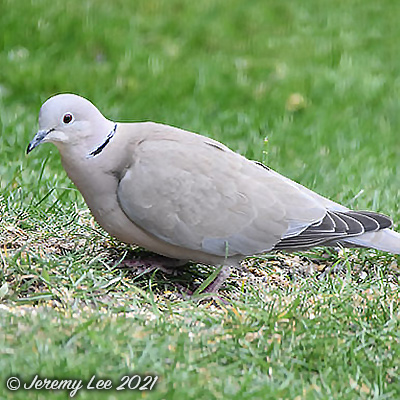
 |
|
Scientific Classifications explained » Amphibians » Ants » Aphids » Bees » Beetles » Birds » Bugs » Butterflies » Caterpillars » Damselflies » Dragonflies » Earwigs » Flies » Frog/Leafhoppers » Fungi » Galls » Grasshoppers » Harvestmen » Hoverflies » Lacewings » Ladybirds » Leaf Mines » Lichens » Mammals » Millipedes » Mosses » Moths » Sawflies » Slugs » Snails » Spiders » Trees & Shrubs » Wasps » Wild Flowers » Woodlice » Postboxes |
UK Nature > Birds > Streptopelia decaocto

Scientific Name: Streptopelia decaocto Common Name: Collared Dove Streptopelia decaocto, more commonly known as the Collared Dove, measures approximately 32cm, having grey / pale brown back and wings, with dark wing-tips and a conspicuous black, white-edged collar around the back of the neck. The underparts are pale grey, often with a pinkish tinge. The call is a rather monotonous, repetitive 'coo-coooo-cu', usually delivered from trees or roof-tops. The accent is on the second note, and the third note is very short and sometimes dropped altogether. The call can then be mistaken for that of a cuckoo, but the cuckoo's call is more musical and the accent is on the first note. Feeds mainly on grain and other seeds on the ground. Their nest is a thin platform of twigs in trees or on buildings. Seen just about anywhere in the UK, often around towns and villages and are common visitors to urban gardens, but Collared Doves only came to the UK in the 1950s, after a rapid spread across Europe from the Middle East. |
|

https://www.uknature.co.uk is a website dedicated to showing the immense diversity of UK nature and wildlife. Our vast range of habitats, from lowland arable to snow covered mountains, from storm-ravaged coastlines to peaceful inland freshwater lakes and rivers, from dry, sandy heaths to deciduous and coniferous forests, all these habitats contribute to the abundance of UK nature. We have wild birds in huge numbers either residing or visiting our shores (597 recorded species as at July 2013) and we must also not forget the humble back garden with its grass lawns, flower beds filled with nectar rich flowers, shrubs and trees, all designed to attract huge numbers of insects such as bees, moths, butterflies and hoverflies; and finally the small ponds which provide safe havens for frogs, toads, newts and even slow worms and grass snakes. www.uknature.co.uk is the showcase for my personal passion, photographing uknature in all its glory. I sincerely hope you all enjoy the fruits of my labours. This site and all images contained therein is © Jeremy Lee 2004 - 2025. All Rights Reserved. Site design by Jeremy Lee. Site development & IT Support by Stuart Lee. |